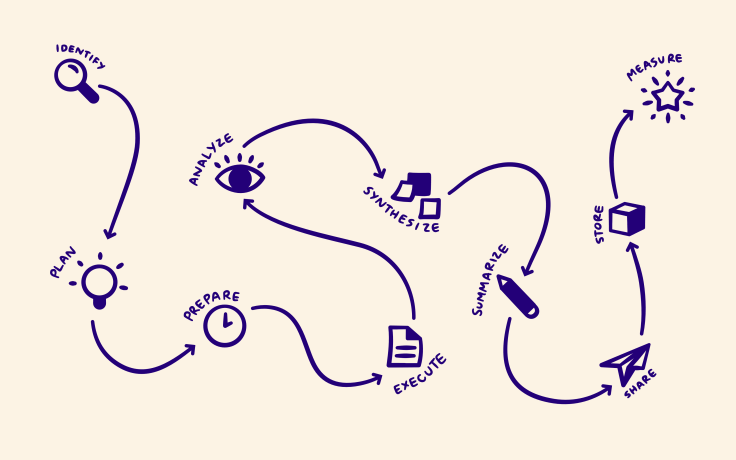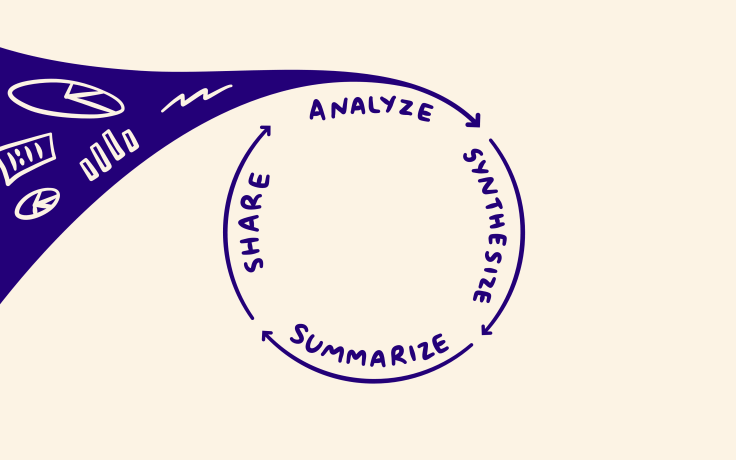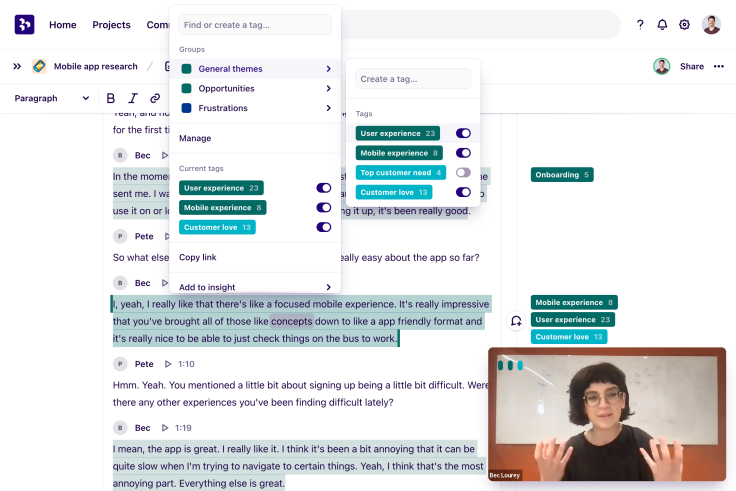What Dovetail does and does not do

One product can’t solve every problem in a user journey. In this blog, we lay out what problems we’re focused on.
Our mission is to improve the quality of every thing, and we know that customer-centric teams build better products for people to use, better experiences for users to engage with, and better services for the public. The path to customer-centricity begins with great customer research—and we’re uniquely positioned to help teams achieve this goal.
We help teams consolidate and understand disparate customer research data through analysis, synthesis, and summarization features. By providing value in these stages of the research journey, we help teams build their research repository organically from the bottom up, enabling them to drive compounding value and continued impact from their investment in research. This is a new category of software that aims to connect data from a variety of fragmented research methods and tools and help teams draw connections between data to form insights.

Our focus
Our current focus is on researchers and designers working in 100-plus person technology companies who conduct continuous research. These groups comprise a large and fast-growing segment with an acute need for our product, and—unlike their peers in product management, marketing, or customer experience—researchers and designers have fewer alternatives for rapid analysis, synthesis, and summarization of research.
We’ve spoken to hundreds of researchers and designers over the years, and we know from our research that there are endless opportunities to solve pain across the entire research journey from planning to archival. However, in order to achieve our mission, we’re focusing our efforts on the middle of the journey—analyze, synthesize, summarize, and share.

Identify, plan, prepare
There are many tools that already solve for these phases of the journey, which involve activities like creating a research plan, defining learning goals, creating project timelines, documenting participant criteria, aligning stakeholders, recruiting and managing participants, and scheduling research sessions. Tools like Confluence, Notion, Google Docs, Calendly, User Interviews, Askable, and Consent Kit have this covered.
While there is opportunity for us to integrate with these tools to create a seamless user experience across the journey, this isn’t a priority right now, and so we’re “avoiding” this part of the journey.
Execute
Execution of research is where the actual data is collected. This could be in an interview, a survey, a usability testing session, or a support ticket. This is a mature, crowded, and fragmented market often split by method.
These tools are primarily focused on productivity for individuals which limits the long-term revenue potential from team-wide engagement. However, it’s critical that our customers can import data from these tools for their journey to continue in Dovetail, so rather than “avoiding” this phase entirely, our strategy is to integrate with the solutions we know people love in order to make it easy to ingest data and proceed.
Examples of some tools in the “execute” phase that we may integrate with:
Interviews: Zoom, Google Meet, Microsoft Teams
Usability testing: UserTesting, Maze, Lookback, Optimal Workshop
Surveying: Typeform, Sprig, SurveyMonkey, Qualtrics, Google Forms
Support: Front, Zendesk, ServiceNow, Jira Service Management

Analyze, synthesize
We have built strong domain knowledge and technical expertise in these phases and have invested in many powerful features to help teams make sense of their unstructured data, from video transcription and highlights, to segmentation with views, and deep search within files.
We also know from our own research that many individuals currently use flexible, horizontal “substitutes” to solve for data analysis and synthesis—tools like Google Docs, Google Sheets, Airtable, Miro. However there are significant challenges with using these tools that are specific to research, and we believe that Dovetail offers significant value beyond what these tools can provide.
Efficient analysis. Tools like Google Sheets and Miro require significant effort to structure raw data. Dovetail leverages structured data to automatically group content and identify themes.
Traceability of data. Retaining a link between research outputs and the original data source helps researchers build trust with stakeholders, resulting in greater buy-in. Traceability is also important for reusing research, and preventing misinterpreting data.
Discoverability of prior research. The flexibility of horizontal tools means they often aren’t intentionally structured to help teams find research based on specific topics, teams, or product areas. This makes finding and analyzing past research difficult, prevents stakeholders from self serving, and leads to teams doubling up on research efforts.
Collaborative research process. Involving stakeholders in the research journey is important for building buy-in, but many horizontal tools are not collaborative. Researchers end up exporting data to other places, meaning inefficient reformatting and resulting in lack of traceability.
Managing participant privacy. Data privacy is an increasing concern for organizations, and researchers are at the forefront. When data is spread across several tools, it’s very difficult for organizations to adhere to privacy policies.
Flexibility in the research process. Horizontal tools usually restrict researchers to analyzing just one kind of data, often specified by the tool rather than their needs. Analysis and synthesis of mixed methods research (like survey data and customer interviews) isn’t possible, preventing researchers from creating a complete and coherent understanding of their customer.
Additionally, given the horizontal nature of these tools, they’re unlikely to invest in purpose-built solutions for research—this means we can develop significant product differentiation in this area, playing to our strengths as a product-led company. For example we may choose to build video anonymization features where Airtable would never build something that specific for their customer base. Differentiated product features, a strong technical moat, and our existing momentum with our brand and product in this phase makes it difficult for a fast-follower to compete with us. We will continue to invest in these phases of the journey.
Research isn’t valuable until the insights that come out of the research are shared. We’ll continue to invest in summarizing (e.g. highlight reels and insights), collaboration features (e.g. comments and notifications), and sharing features (e.g. public links). We’ll also integrate with collaboration tools like Slack and Confluence to meet stakeholders where they are.

Measure, store
After research is completed, many teams “archive” their data and reports for the future. Often that happens in tools like Google Drive, Dropbox, Sharepoint, or Confluence. We also hear researchers ask for better ways to measure the impact of their research, through features like engagement analytics and integrations with product management tools like Jira, Productboard, and Asana to close the loop. In the immediate term, focusing on the earlier phases of the journey above will allow us to learn more about the customer needs in these phases and will expand our investment here in the future.
Looking to the future
Until now, we’ve focused mainly on solving for the needs of researchers and designers (methods like interviews and usability testing). But we know that customer-facing research is much more than solely interviewing customers over Zoom. For example, product managers will analyze product feedback, customer success managers and support teams might handle complaints, and account executives might capture sales demos.
To help teams consolidate their data and build a compounding research repository, we’re expanding what data we support in Dovetail. We’re investing in solving for other common research methods like surveys, product feedback, NPS, and more. Driving flexibility and expanding the methods and data formats that Dovetail supports will allow us to expand to more roles and teams doing different kinds of research, as an essential research tool across the business.


